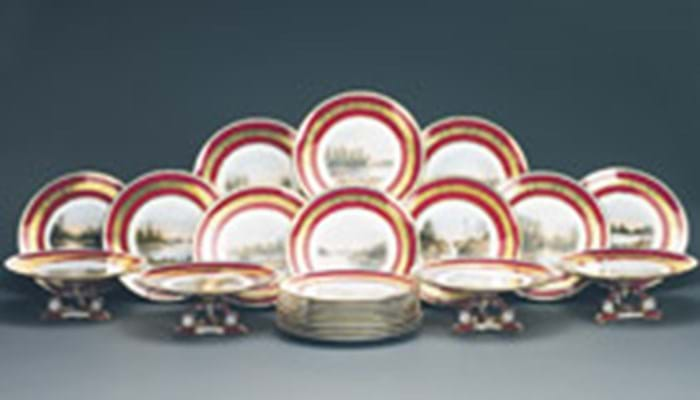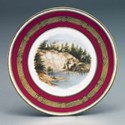However, when that topographical decoration is identified as a Canadian location and, importantly, is offered for sale in that region, all the financial goalposts move. So Waddington's of Toronto discovered when the Canadian auction house offered a 22-piece Aynsley dessert service on December 12 and saw it sell for Can$48,000 (£22,860) plus 20 per cent premium.
The service turned up on a Canadian Antiques Roadshow brought in by a local vendor in whose family it had descended from the 1880s. Each of the 9in (22cm) plates, with their gilded red borders, features a delicately painted river or lakescape. All were fully marked with the factory name and design registration code for December 2, 1879, and all bore scripted titles in red and brown.
Those titles really mattered. These were not the usual Highland loch or British lakelands one might expect from the factory but views of The Muskoka region, a ruggedly beautiful area north of Toronto, between Lake Huron and Lake Ontario, including scenes of Lake Muskoka, the Muskoka River and Georgian Bay.
Canadian subject matter is seldom seen on 19th century porcelain and as such is highly desirable. Some ATG readers may remember the £71,500 tallied at Bonhams' Minton Museum sale in 2002 by 21 plates and comports from a service commemorating a British Trans-Canadian expedition of the early 1860s. They were painted with narrative topograph-ical scenes based on drawings and photos by expedition member Dr William Cheadle.
The source for Waddington's Muskoka service is thought to be Seymour Penson's illustrations in the 1879 Guide Book and Atlas of Muskoka and Parry Sound which bear strong similarities to the Aynsley scenes. Only one other Muskoka service is known to exist, four pieces of which are in the Royal Ontario Museum and it seems very likely that it was a special commission from the Staffordshire factory, possibly ordered by a lumber baron.
Not surprisingly, Waddington's service generated considerable interest from Canadian museums keen to secure this piece of local history but they were pipped at the post by the successful purchaser, a private buyer from outside the province.
By Anne Crane
Canadian views of the Aynsley factory
Aynsley China has a history stretching back to 1775 when John Aynsley first started producing ceramics in Longton, Staffordshire. Its enduring reputation is for its bone china tablewares decorated with floral sprays or fruit in the manner of Royal Worcester, or for its commemorative pieces. They remain very affordable and even Aynsley’s well-painted cabinet plates featuring British landmarks usually cost less than £100.








